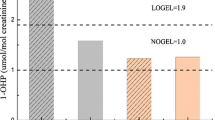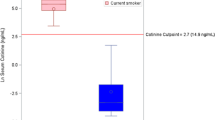Abstract
Few studies have examined the effects of environmental concentrations of benzene, toluene, ethylbenzene, and xylene (BTEX) on the hematologic system of residents near a petrochemical complex. This study evaluated the potential effects of blood BTEX concentrations on the hematologic parameters of residents in a community near a petrochemical complex (contaminated group) and another community free of known petrochemical pollution (control group). Volunteer residents were randomly recruited. Each participant completed a questionnaire and donated blood samples to evaluate blood BTEX concentrations and hematologic parameters. We found the mean concentrations of blood BTEX of the contaminated group were 1.2 to 6.7 times higher than the control group. Multiple hematologic parameters of participants were significantly different between the two study groups. Inverse associations were found for ln-transformed blood benzene concentrations with mean corpuscular hemoglobin concentration (MCHC) (β = − 2.75) and platelet counts (β = −8.18). Several weaker associations were also observed between other compounds and multiple hematologic parameters. Our results suggest that the residents living near petrochemical complexes have higher blood BTEX concentrations. Furthermore, the increased blood BTEX levels in residents are associated with the reduction in RBC counts, hemoglobin concentration, hematocrit, MCHC, and platelet counts. This study provided particularly important information for the health risk assessment of residents living near petrochemical complexes.

Similar content being viewed by others
Abbreviations
- BTEX:
-
benzene, toluene, ethylbenzene, and xylene
- BMI:
-
body mass index
- GLMs:
-
generalized linear models
- HGB:
-
Hemoglobin
- LOD:
-
limit of detection
- MCHC:
-
mean corpuscular hemoglobin concentration
- MCV:
-
mean corpuscular volume
- RBC:
-
red blood cell
- SD:
-
standard deviation
- VOCs:
-
volatile organic compounds
- WBC:
-
white blood cell
References
Aksoy M (1989) Hematotoxicity and carcinogenicity of benzene. Environ Health Perspect 82:193–197
Ashley DL, Prah JD (1997) Time dependence of blood concentrations during and after exposure to a mixture of volatile organic compounds. Arch Environ Health 52:26–33. https://doi.org/10.1080/00039899709603796
Ashley DL, Bonin MA, Cardinali FL, McCraw JM, Wooten JV (1996) Measurement of volatile organic compounds in human blood. Environ Health Perspect 104(Suppl):871–877. https://doi.org/10.1289/ehp.96104s5871
Bird MG, Wetmore BA, Letinski DJ, Nicolich M, Chen M, Schnatter AR, Whitman FT (2010) Influence of toluene co-exposure on the metabolism and genotoxicity of benzene in mice using continuous and intermittent exposures. Chem Biol Interact 184:233–239. https://doi.org/10.1016/j.cbi.2010.01.012
Blount B, Kobelski R, Mcelprang D, Ashley D, Morrow J, Chambers D, Cardinali F (2006) Quantification of 31 volatile organic compounds in whole blood using solid-phase microextraction and gas chromatography–mass spectrometry☆. J Chromatogr B 832:292–301. https://doi.org/10.1016/j.jchromb.2006.01.019
Bolden AL, Kwiatkowski CF, Colborn T (2015) New look at BTEX: are ambient levels a problem? Environ Sci Technol 49:5697–5703. https://doi.org/10.1021/es505316f
Brugnone F, Perbellini L, Maranelli G, Romeo L, Guglielmi G, Lombardini F (1992) Reference values for blood benzene in the occupationally unexposed general population. Int Arch Occup Environ Health 64:179–184
Casale T, Sacco C, Ricci S, Loreti B, Pacchiarotti A, Cupelli V, Arcangeli G, Mucci N, Antuono V, de Marco F, Tomei G, Tomei F, Rosati MV (2016) Workers exposed to low levels of benzene present in urban air: assessment of peripheral blood count variations. Chemosphere 152:392–398. https://doi.org/10.1016/j.chemosphere.2016.01.096
Chambers DM, Ocariz JM, McGuirk MF, Blount BC (2011) Impact of cigarette smoking on volatile organic compound (VOC) blood levels in the U.S. population: NHANES 2003–2004. Environ Int 37:1321–1328. https://doi.org/10.1016/j.envint.2011.05.016
Doherty BT, Kwok RK, Curry MD, Ekenga C, Chambers D, Sandler DP, Engel LS (2017) Associations between blood BTEXS concentrations and hematologic parameters among adult residents of the U.S. Gulf States. Environ Res 156:579–587. https://doi.org/10.1016/j.envres.2017.03.048
Esplugues A, Ballester F, Estarlich M, Llop S, Fuentes-Leonarte V, Mantilla E, Iñiguez C (2010) Indoor and outdoor air concentrations of BTEX and determinants in a cohort of one-year old children in Valencia, Spain. Sci Total Environ 409:63–69. https://doi.org/10.1016/j.scitotenv.2010.09.039
Galbraith D, Gross SA, Paustenbach D (2010) Benzene and human health: a historical review and appraisal of associations with various diseases. Crit Rev Toxicol 40:1–46. https://doi.org/10.3109/10408444.2010.508162
Goldstein BD (1977) Benzene toxicity: a critical evaluation: hematotoxicity in humans. J Toxicol Environ Health Suppl 2:69–105
Hristeva-Mirtcheva V (1998) Changes in the peripheral blood of workers with occupational exposure to aromatic hydrocarbons. Int Arch Occup Environ Health 71(Suppl):S81–S83
Hsu C-Y, Chiang H-C, Shie R-H, Ku CH, Lin TY, Chen MJ, Chen NT, Chen YC (2018) Ambient VOCs in residential areas near a large-scale petrochemical complex: spatiotemporal variation, source apportionment and health risk. Environ Pollut 240:95–104. https://doi.org/10.1016/j.envpol.2018.04.076
Jia C, Yu X, Masiak W (2012) Blood/air distribution of volatile organic compounds (VOCs) in a nationally representative sample. Sci Total Environ 419:225–232. https://doi.org/10.1016/j.scitotenv.2011.12.055
Khuder SA, Youngdale MC, Bisesi MS, Schaub EA (1999) Assessment of complete blood count variations among workers exposed to low levels of benzene. J Occup Environ Med 41:821–826
Kirkeleit J, Riise T, Bjørge T, Christiani DC (2013) The healthy worker effect in cancer incidence studies. Am J Epidemiol 177:1218–1224. https://doi.org/10.1093/aje/kws373
Koh D-H, Jeon H-K, Lee S-G, Ryu H-W (2015) The relationship between low-level benzene exposure and blood cell counts in Korean workers. Occup Environ Med 72:421–427. https://doi.org/10.1136/oemed-2014-102227
Lan Q, Zhang L, Li G, Vermeulen R, Weinberg RS, Dosemeci M, Rappaport SM, Shen M, Alter BP, Wu Y, Kopp W, Waidyanatha S, Rabkin C, Guo W, Chanock S, Hayes RB, Linet M, Kim S, Yin S, Rothman N, Smith MT (2004) Hematotoxicity in workers exposed to low levels of benzene. Science 306:1774–1776. https://doi.org/10.1126/science.1102443
Lee CR, Yoo CI, Lee JH, Kim SR, Kim Y (2002) Hematological changes of children exposed to volatile organic compounds containing low levels of benzene. Sci Total Environ 299:237–245
Lin YS, Egeghy PP, Rappaport SM (2008) Relationships between levels of volatile organic compounds in air and blood from the general population. J Expo Sci Environ Epidemiol 18:421–429. https://doi.org/10.1038/sj.jes.7500635
Liu B, Liang D, Yang J, Dai Q, Bi X, Feng Y, Yuan J, Xiao Z, Zhang Y, Xu H (2016) Characterization and source apportionment of volatile organic compounds based on 1-year of observational data in Tianjin, China. Environ Pollut 218:757–769. https://doi.org/10.1016/j.envpol.2016.07.072
Lubin JH, Colt JS, Camann D, Davis S, Cerhan JR, Severson RK, Bernstein L, Hartge P (2004) Epidemiologic evaluation of measurement data in the presence of detection limits. Environ Health Perspect 112:1691–1696
Masih A, Lall AS, Taneja A, Singhvi R (2017) Exposure profiles, seasonal variation and health risk assessment of BTEX in indoor air of homes at different microenvironments of a terai province of northern India. Chemosphere 176:8–17. https://doi.org/10.1016/j.chemosphere.2017.02.105
Mchale CM, Zhang L, Smith MT (2012) Current understanding of the mechanism of benzene-induced leukemia in humans: implications for risk assessment. Carcinogenesis 33:240–252. https://doi.org/10.1093/carcin/bgr297
Moszczynski P, Lisiewicz J (1982) T and B cells and occupational exposure to benzene and its homologues (with regard to other blood cells). Rev Esp Oncol 29:49–55
Moszczyński P, Lisiewicz J (1983) Hematological indices of peripheral blood in workers occupationally exposed to benzene, toluene and xylene. Zentralbl Bakteriol Mikrobiol Hyg B 178:329–339
Oiamo TH, Johnson M, Tang K, Luginaah IN (2015) Assessing traffic and industrial contributions to ambient nitrogen dioxide and volatile organic compounds in a low pollution urban environment. Sci Total Environ 529:149–157. https://doi.org/10.1016/j.scitotenv.2015.05.032
Paciência I, Madureira J, Rufo J, Moreira A, Fernandes EO (2016) A systematic review of evidence and implications of spatial and seasonal variations of volatile organic compounds (VOC) in indoor human environments. J Toxicol Environ Health B Crit Rev 19(2): 47–64. https://doi.org/10.1080/10937404.2015.1134371
Pelallo-Martínez NA, Batres-Esquivel L, Carrizales-Yañez L, Díaz-Barriga FM (2014) Genotoxic and hematological effects in children exposed to a chemical mixture in a petrochemical area in Mexico. Arch Environ Contam Toxicol 67:1–8. https://doi.org/10.1007/s00244-014-9999-4
Protano C, Andreoli R, Manini P, Guidotti M, Vitali M (2012) A tobacco-related carcinogen: assessing the impact of smoking behaviours of cohabitants on benzene exposure in children. Tob Control 21:325–329. https://doi.org/10.1136/tc.2010.039255
Qu Q, Shore R, Li G, Jin X, Chi Chen L, Cohen B, Melikian AA, Eastmond D, Rappaport SM, Yin S, Li H, Waidyanatha S, Li Y, Mu R, Zhang X, Li K (2002) Hematological changes among Chinese workers with a broad range of benzene exposures. Am J Ind Med 42:275–285. https://doi.org/10.1002/ajim.10121
Sarigiannis DA, Karakitsios SP, Gotti A, Liakos IL, Katsoyiannis A (2011) Exposure to major volatile organic compounds and carbonyls in European indoor environments and associated health risk. Environ Int 37:743–765. https://doi.org/10.1016/j.envint.2011.01.005
Song Y, Shao M, Liu Y, Lu S, Kuster W, Goldan P, Xie S (2007) Source apportionment of ambient volatile organic compounds in Beijing. Environ Sci Technol 41:4348–4353
Tohon HG, Fayomi B, Valcke M, Coppieters Y, Bouland C (2015) BTEX air concentrations and self-reported common health problems in gasoline sellers from Cotonou, Benin. Int J Environ Health Res 25:149–161. https://doi.org/10.1080/09603123.2014.915017
Tong L, Liao X, Chen J, Xiao H, Xu L, Zhang F, Niu Z, Yu J (2013) Pollution characteristics of ambient volatile organic compounds (VOCs) in the southeast coastal cities of China. Environ Sci Pollut Res 20:2603–2615. https://doi.org/10.1007/s11356-012-1187-3
Wetmore BA, Struve MF, Gao P, Sharma S, Allison N, Roberts KC, Letinski DJ, Nicolich MJ, Bird MG, Dorman DC (2008) Genotoxicity of intermittent co-exposure to benzene and toluene in male CD-1 mice. Chem Biol Interact 173:166–178. https://doi.org/10.1016/j.cbi.2008.03.012
World Health Organization Regional Office for Europe (2000) Air Quality Guidelines for Europe SecondEdition. WHO Regional Publications, European Series, No. 91.http://www.euro.who.int/__data/assets/pdf_file/0005/74732/E71922.pdf. Accessed 10 Feb 2019
Yoon BI, Hirabayashi Y, Kawasaki Y et al (2001) Mechanism of action of benzene toxicity: cell cycle suppression in hemopoietic progenitor cells (CFU-GM). Exp Hematol 29:278–285
Funding
This study was supported by funds from the Key Talent Project for Medical Young Scholars of Jiangsu Province (QNRC2016551) and Jiangsu social development project (BE2018745).
Author information
Authors and Affiliations
Contributions
QC and HS contributed to the study design, data procurement, results interpretation, and drafting of the article. JZ was involved in collection of the data. ZD and YX took part in the study design, supervision of the research, data procurement and results interpretation. All authors read and gave their approval for publication.
Corresponding author
Ethics declarations
Availability of data and materials
The data that support the findings of this study are available from Jiangsu Provincial Commission of Health and Family Planning; however, restrictions apply regarding the availability of these data, which were used under a license for the current study, and the data are not publicly available. Data are however available from the authors upon reasonable request and with permission of Jiangsu Provincial Commission of Health and Family Planning.
Consent for publication
Not applicable.
Ethics approval and consent to participate
The study protocol was approved by the Ethic Commission of Jiangsu Provincial Center for Disease Control and Prevention; all study participants provided written informed consent.
Competing interests
The authors declare that they have no competing interests.
Additional information
Responsible editor: Philippe Garrigues
Publisher’s note
Springer Nature remains neutral with regard to jurisdictional claims in published maps and institutional affiliations.
Rights and permissions
About this article
Cite this article
Chen, Q., Sun, H., Zhang, J. et al. The hematologic effects of BTEX exposure among elderly residents in Nanjing: a cross-sectional study. Environ Sci Pollut Res 26, 10552–10561 (2019). https://doi.org/10.1007/s11356-019-04492-9
Received:
Accepted:
Published:
Issue Date:
DOI: https://doi.org/10.1007/s11356-019-04492-9




